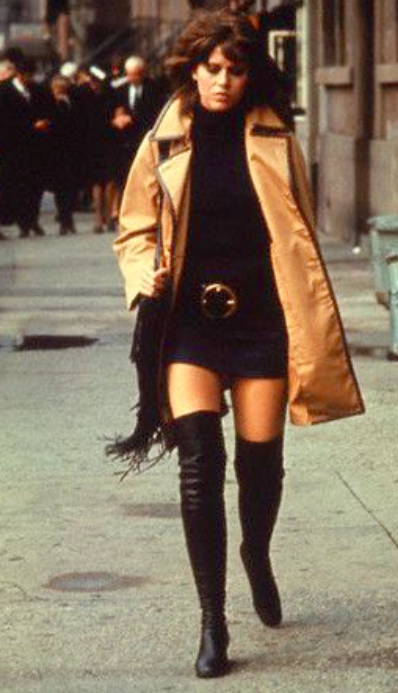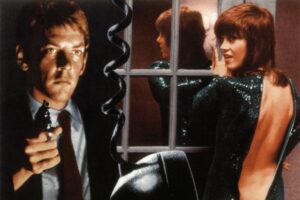Funny Ha Ha in All Its Unglamorous Glory
Funny Ha Ha’s charm sneaks up on you in the same flatfooted, backhanded way as its characters do. Grainy, not even prettily unpretty, and superficially inarticulate, it draws less directly on Cassavetes’ cinema verité than on early John Sayles films like Return of the Secaucus 7 (the 1980 inspiration for better-known, worse-for-wear The Big Chill).
Like Sayles’ early movies, which no doubt draw in turn on Cassavetes (at that, the entire genres of reality TV and Dogme 95 should be laying wreaths at his grave), Funny Ha Ha ambles along with less of an explicit agenda than with a set of circumstances, ones that 24-year-old unemployed Marnie (Waking Life animator Kate Dollenmayer) idly nudges with her long, unmanicured toe. In Secaucus 7 especially, Sayles succeeded admirably at making plausible sexual desire between characters who, though not repulsive, wouldn’t necessarily be considered attractive by audiences watching them. That’s a lost art, for sure; a lost ambition, even, in this era when “would you fuck her/him?” prevails as the most urgent casting question (Shrek aside). And it’s an art resurrected by director Andrew Bujalski, who has captured in Funny the bloodless exchanges of a certain breed of Greater Boston-based recent grads. But that’s where the comparison between Bujalski’s and Sayles’ characters, also New England-based, stops. For whereas the Secaucus guys wring their hands over ideological questions and the wisdom of their choices, Marnie and her loose network of friends are just starting to arrive at the idea that commitment of any kind is required in life — if only in terms of committing to a clear sentence.
In his review, A.O. Scott shows his old-school colors when he describes the film as “a generational statement.” The movie’s “statement,” a term that may be too strident for this mumbling venture, is at once much more universal and much more specific than that. Specifically, it’s about the type of middle-class, recent grads who proliferate Neutered England. Basically nice kids (in Boston, you’re called kid until you die) who’ve got no play.
The film looks as if it were shot back in a Slacker ‘90s, when boys and girls alike donned the androgyne uniform of unflattering jeans and ripped, unironic tee shirts, but that’d be Bostonian twentysomethings in their natural habitat in any era, alas. It’s hard to imagine how these kids will get around to procreation (or doing the things required for procreation) until you realize that they’re infinitely patient with each other as they’re all, at least, similarly socially retahded. They slouch; they’re post-ironic enough that they apologize endlessly if even a little presumptuousness creeps into their tone; they barely meet each other’s eyes; and though you suspect their alma maters weren’t community colleges, they’re hard-pressed to formulate a direct thought or request, especially if it trespasses into the world of emotions or, God forbid, carnality. (In an NPR interview, Bujalski acknowledges that all the ums, likes and you knows that his nonprofessional cast utter all like you know pretty much derive verbatim from the script).
In any other film, for example, Alex, Marnie’s unrequited love, would be the hopeless sadsack rather than the glib Lothario who dances (awkwardly) in the face of Marnie’s wistful affections. He’s got small, shifty eyes, wears white sneakers with his jeans, and mumbles rather than fumbles once he gets a girl out on her porch in the middle of the night. If you know what I mean. Watching all these characters stumble around their desires is as excruciating as watching your seventh grade math teacher (the one in a short-sleeved button-down and a pen protector) putting the mack on a girl.
But that’s the charm of the film. There isn’t a soundtrack. There are no clever pop culture references. There are no montages. There are no big showdowns. There’s nothing, in fact, to mitigate the excruciating self-consciousness of one’s 20s, which is typically aggrandized without measure in both American and European cinema alike. In Marnie’s features and body, for example, you can glimpse an inkling of a woman who may one day be beautiful, but right now is inchoate and hopelessly floppy, a female equivalent to Linklater’s Wiley Wiggins. When she applies for a position as a research assistant, the professor who interviews her seems less stodgy than self-assured, insouciant compared to Marnie and her crew’s fidgety self-consciousness. Rather than wrinkled, his features seem, well, defined. And they remind us how, for most of us in the real world (the cinema verité kind as opposed to the reality TV world), one’s 20s are actually years to fast-forward through as rapidly as possible. The weight of the world-as-oyster is actually fairly intolerable.
When watching this film at Cinema Village, I was sure it’d just look like shitty public access if seen on a TV (not that CV’s screens are much better). But when I got home, it was playing on the Sundance Channel, and I settled in with a surprising degree of pleasure to watch Marnie float through a sea of bad parties and awkward encounters one more time. It makes sense, though: A lot of Funny‘s appeal stems from its rejection of typical filmic devices; dramatic moments that would typically escalate into either slapstick or confrontation merely devolve. At one moment, for example, while Marnie is waiting for Alex in his bedroom, she happens upon some other girl’s birth control pills. She puts them away, then fiddles with his tiny wrench to an effect that is sadly, slowly funny.
Made back in 2003 and only now hitting theaters in cities like NYC, Funny Ha Ha has taken its sweet time to gain any momentum — also like its characters — but it has finally accrued the kind of critical accolades typically only awarded European film these days. And it has a sort of European feel, in its closeups and blurred edges. Even the film’s ending, obstensibly the resolution of the film’s only dramatic conflict, is swallowed rather than spat. A welcome restraint.
House of Whack(s)
House of Wax has got to be the loopiest Doublemint commercial ever made. Starring not one but three sets of errant twins — fraternal teens, fraternal serial killers, and Paris Hilton’s (fraternal) tweens — it takes more cues from ’70s slash-and-gash than the J horror inspiring the recent spate of psychological terrors (the Ring franchise, vanilla bean Boogeyman). And, lo, it’s got little in common with the 1953 Vincent Price vehicle of the same name. Except for, well, wax.
This House poises a gaggle of road-tripping teens at the wrong campsite. Enter a bone-squelching, squirting set of murders, dumber-than-dirt dialogue (like, my cell reception totally sucks, you guys!) and a lot of innuendo between future has-been Chad Michael Murray as Goofus to his scrappy-sexy twin Elisha Cuthbert’s Gallant. A tortured artist who wears an ominous mask and is ace with a blade. A goofball sidekick with the now-standard video camera. A black stud making it with a flaxen nymphette, as interpreted by Paris-Barbie Hilton. Box-office gold, in other words, for who’d resist watching that corporation-unto-herself put into, uh, bankruptcy once and for all? With no less than a pole rammed through her least vital organ, as my colleague delicately pointed out.
Which brings me to my three cents:
1. Never has a movie invited more Mystery Science 3000 narration. Best for DVD, albeit with the parental warning: To be watched in the comfort of your own snark.
2. Any Moral Majority that would have me as a member (or is that any member that would have me as its Moral Majority?) would be protesting the movie’s violence-as-porn already.
3. I am convinced that the under-25 airess has submitted to botox already. Insert Paris Hilton wax joke here, dollbabies. I’m just too underwhelmed.
Dickless Jane (Klute with Just a Dash of Leaving Las Vegas)
 The sudden reemergence of The Many Faces of Lady Hanoi Jane Vadim Hayden Turner Fonda (a possibly ill-advised return from retirement, the new book) has inspired me to revisit Klute (1971). In it, she portrays Bree, a stalked prostitute who spends her free time shtupping detective Donald Sutherland, then processing the affair with such a clinical remove that it as if she’s her shrink’s colleague, not client. Like everything else Fonda, her depiction of Bree shouldn’t be as effective as it is.
The sudden reemergence of The Many Faces of Lady Hanoi Jane Vadim Hayden Turner Fonda (a possibly ill-advised return from retirement, the new book) has inspired me to revisit Klute (1971). In it, she portrays Bree, a stalked prostitute who spends her free time shtupping detective Donald Sutherland, then processing the affair with such a clinical remove that it as if she’s her shrink’s colleague, not client. Like everything else Fonda, her depiction of Bree shouldn’t be as effective as it is.
No matter what the role, Fonda never ditches her clipped, boarding-school diction. The effect is distancing–even condescending–though she sometimes may intend the opposite, especially when portraying working-class women (as in Stanley and Iris) or working girls (as in Klute). Those precise, strident tones–dare I call them “brays”–ring hollow, as if she holds these women at such bay that she is speaking of rather than as them.*
But in Klute that distance works, partly because Bree is someone who holds herself at bay. She also brilliantly evokes that hush which creeps into a life unpopulated by real human connection. In her presence, even Sutherland seems uncharacteristically muted. Alone in her poorly lit rooms, she smokes dope, leafs through books, stares down her ugly walls with the grim resignation of someone who knows a silence that threatens to extend forever. Backlit by Gordon Willis’ gorgeously melancholy cinematography, she luxuriates in her isolation as if it were warm, dirty bathwater. You feel rather than observe that she can tolerate no intruder save her cat, and that kindness unwires her, even angers her, however irrational she recognizes that fact to be.
Klute is not a terrific movie by any stretch of the imagination. It falls prey to many ‘70s movies pitfalls, including a surplus of self-important pauses and poorly built suspense. (A high, female voice accompanied by  a single piano note does not in and of itself conjure fear.) But the first time I saw it I’d been alone for a long, long time, and it felt so familiar it was as if I were kissing my own arm.
a single piano note does not in and of itself conjure fear.) But the first time I saw it I’d been alone for a long, long time, and it felt so familiar it was as if I were kissing my own arm.
*Also, why hasn’t anyone pointed out that Shue’s prostitute character in Leaving Las Vegas draws so much on Fonda’s Bree? Both women strut and speechify with that aggressively middle-class can-do assertiveness, and both films deploy that oy-vey storytelling technique of a broad confiding in her off-camera shrinks while jazz trumpets bleakly.
